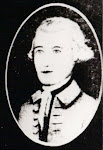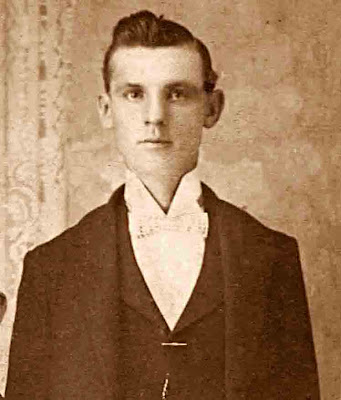In the summer of 1991,
descendants of Stephen Moore (1734-1799) of Mount Tirzah, North Carolina,
assembled at the U.S. Military Academy at West Point for a family reunion. The
location was appropriate because Stephen Moore had inherited the West Point
property upon the death of his father, Col. John Moore (1686-1749) of New York
City, then subsequently sold it to the U.S. government in 1790, upon which the
USMA was established in 1802. Of the approximately 200 attendees, from all
parts of the country, many were meeting for the first time. Some were
acquainted through genealogical research. In my case, I had been studying the
Moore family for about eight years, and I was just learning of some
discrepancies in the lineage in 1991, but was too inexperienced to know how to
resolve them.
Soon after the
reunion, however, I was put into contact with the family of Richard Channing
Moore, who was a descendant of Stephen Moore’s elder brother, Thomas
(1721-1794). Richard C. Moore had left a family chart at the West Point
Library, and when I wrote to him, I learned that
he had died a short time
before. His wife Marjorie was very gracious in sharing the information that
Richard had compiled in his study of the Moore lineage. Richard had encountered
the same discrepancies that I had, but instead of wondering about them, he
hired a genealogist in Philadelphia, and another in London to resolve them with
limited success. Additionally, right before the West Point reunion, Dr. Victor
Moore of Evans, Georgia, put me in contact with Mrs. Marguerite Roll.
Marguerite was not a Moore descendant, but she wanted to obtain the Moore coat
of arms as a gift to friends who were. (I never learned their names.) She was
working with
the Lancaster Herald at the College of Arms in London in order to
accomplish this goal, and she had supplied him with the information she had:
David Moore Hall’s Six
Centuries of Moores of Fawley,
published in 1904. Early in my studies of the Moore clan, I obtained a copy of Six Centuries which I used as a guide for my continuing research.
The Lancaster Herald could not reconcile the lineage as written in Six Centuries with what was on record at the College of Arms. There
was a major error in the lineage detailed in Six Centuries, namely that Francis Moore of Fawley was said to have
married in 1655 Mary Cary, daughter of Edward Cary. Francis Moore and Mary Cary
were the supposed parents of John Moore, born in 1658. However, the Cary
lineage shows that Mary, daughter of Edward Cary was born 50 years after the
alleged marriage. Further, the arms granted to the Moores of Fawley are
described as “Argent, a Moorcock, Sable” [a black Moorcock on a silver or white
shield] and were granted in 1569 to Nicholas Moore, Esq. The arms used by the
American branch of Moores of this study is described as “Argent, Ten Crosses
Crosslet, Sable” [10 black crosses crosslet on a silver or white shield]. I
would point out here that this coat of arms was used by four men: Thomas Moore,
the Librarian at Westminster Abbey and Hon. John Moore’s brother; William Moore
(1699-1783) of Chester County, Pennsylvania, son of Hon. John Moore, brother of
Col. John Moore and father of Thomas
William Moore (1735-1799), who played a
large roll in the misidentification of the correct lineage; John Moore, Esq.
(1745-1828), son of Thomas Moore of New York City, grandson of Col. John Moore,
nephew of Stephen Moore, family historian and author of at least four known
memoirs and countless family letters; and Stephen Moore himself, on the
bookplate of the family bible that belonged to his daughter, Mary (Moore)
Stanford. Notably, neither Hon. John Moore of Philadelphia nor Col. John Moore
of NYC used the ten crosses, crosslet arms on any seal or bookplate that is
extant. The Lancaster Herald stated that it was his belief that Thomas Moore,
Librarian of Westminster, assumed the use of ten crosses, crosslet without
authority, and
indicated that no Moores had ever been granted arms ten crosses,
crosslet.
As the exchange of
information continued, we asked the Lancaster Herald to verify the story
reported by John Moore, Esq. in one version of his memoirs, that his cousin,
Thomas William Moore (1735-1799), traveled to London in 1770 and received the
Moores of Fawley genealogy from the “Herald’s Office.” The Herald’s report was
as follows: “...I can confirm that such visits were (and still are) recorded
and the records preserved. I have examined those for 1770, but I find that only
two enquiries were received that year relating to persons or families of the
name of Moore: the first, in July related to one Giles Moore of Middleton, co.
Westmorland, no record of whom could be found, and the second, in August, to
the family of Moore of Appleby, co. Leicester, whose pedigree had already been
registered.”, and “...I have examined the Waiting Books for the period from
July 1767 to December 1776 without however finding any record of an enquiry
relating to the Moores of Fawley.” Thus, it seems that the myth of our Moores
of Fawley lineage originated with Thomas William Moore in 1770, which was then accepted
without question for the next 225 years. None of the American descendants had
any reason to question or doubt it. Whether Thomas William Moore was duped by
an unscrupulous genealogist, or was led astray by his relations still residing
in England, we may never know, but in one way, it made my research easier.
Since all the generations after Thomas William Moore adhered to the Moores of
Fawley lineage, I could be certain I was on the right track if there was ever
any mention of Fawley, as in the case of John Moore (1820-1903) of Quincy,
Adams County, Illinois, who named his home Fawley.
Now, 21 years after
the West Point reunion, a great deal of research has resulted in many new
discoveries of which the majority of the attendees are unaware. A recent
research and pleasure trip to North Carolina gave me the opportunity to renew
some acquaintances with cousins and meet others for the first time. Many Moore
descendants still live in North Carolina, in Person County where Mount Tirzah,
Stephen Moore’s home is situated, in Orange, Alamance, Durham, Granville, Wake,
even New Hanover and many more. In addition to learning “new” things about
under-explored branches of the family, my purpose was to share the results of
the intervening 20+ years of research with those who were unaware of it.
Descendants of Stephen Moore’s son, Portius (1784-1847), the
Horner/Graham/Hall/Cooper families lived in Oxford, Granville County. At the
home of Lea Lea Ivey, I presented these findings to a small group of cousins
who were learning of the different lineage for the first time. Needless to say,
the news was met with some polite skepticism. One of the long-held stories in
that branch of the family was of the trip to England and Fawley Manor made in
1888 by their ancestress, Sophronia (Moore) Horner (1829-1909). In their
understanding, Sophronia had seen etched in a pane of glass at Fawley Manor,
the names of three girls, one of them being “Sophronia.” Though I remembered
seeing that story long ago, I could not recall its source, so could not counter
the argument at the time. When I returned home, I quickly found the source of
the story: in the pages of Six Centuries of Moores of Fawley. In a perfect example of how family stories sometimes
get distorted over time (but must never be discounted!), the account of the
trip to Fawley was :
“Our kinswoman, Mrs.
Lilie Moore Craven, thus writes of her visit to Fawley in 1888: ‘Doctor
Gardiner went with us to the old manor house at Little Fawley, about a mile
from the Vicarage, which was unoccupied, save that some of the numerous rooms
were used for farm purposes. We walked through the ancient rooms, gazed upon
the landscape from the upper windows, went upon the roof, read the names cut
with a diamond upon the window panes, namely Mollie Moore, Nellie Moore, Anastasia
Moore, Sir R Moore, and I thought of
those who formerly occupied the mansion and wondered how they looked.’ ”
With the enormous
databases containing original records now available on websites such as
FamilySearch and Ancestry, research is greatly facilitated. I tracked Rev.
Elijah R. Craven (1824- 1908) and his wife, Elizabeth Gertrude Moore (1832- ),
daughter of Stephen van Rensselaer Moore (1799-1883), and granddaughter of
Bishop Richard Channing Moore (1762-1841), in census records of
1870, 1880 and 1900. One of the features of Ancestry searches is “hints”
pointing the researcher to other records that may pertain to the individual you
are researching. In this case, the hint pointed toward passport applications.
On 22 May 1888, Elijah R. Craven was issued a passport to travel abroad
“accompanied by my wife Elizabeth G. Craven.”
I cannot emphasize
enough, the value of incorporating all family histories, genealogies, oral
traditions, letters and manuscripts, memoirs and the research of others into
this ongoing, and constantly expanding study of the vast Moore clan, but I
offer this caveat: anything written before 1995 is subject to the “Fawley myth” and should be considered a guide useful
for clues. Likewise, the many genealogies posted on current websites such as
Ancestry and FamilySearch must be used in the same way, as most are derivative
of the “Fawley myth.” Fellow researchers and cousins, Steve Moore, David
Jeffreys and Sandra (Moore) Shoffner have worked tirelessly to distribute
accurate information and I urge anyone interested to visit David’s excellent
blog: Stephen Moore of Mt.
Tirzah Family.
One visit won’t be
enough! Or to obtain the CD compiled by Steve Moore containing much of the
research since 1995 and photos of Mt. Tirzah, the family cemetery, Mt. Tirzah
Church burial ground, and much more, contact Steve at: moore217@comcast.net.
Any
information in your possession that may be of interest to all, such as family
portraits, documents, family bible pages, letters, diaries or journals, please
consider copying or photographing and sharing with all or any of us: Terri
O’Neill tbo45@mac.com, Sandra Shoffner smshoffner@triad.rr.com,
Steve Moore and David Jeffreys david@ladyslippercove.com.
~~Terri Bradshaw O'Neill, July 2013







































.jpg)
.jpg)
.jpg)
.jpg)
.jpg)
.jpg)
.jpg)
.jpg)
















